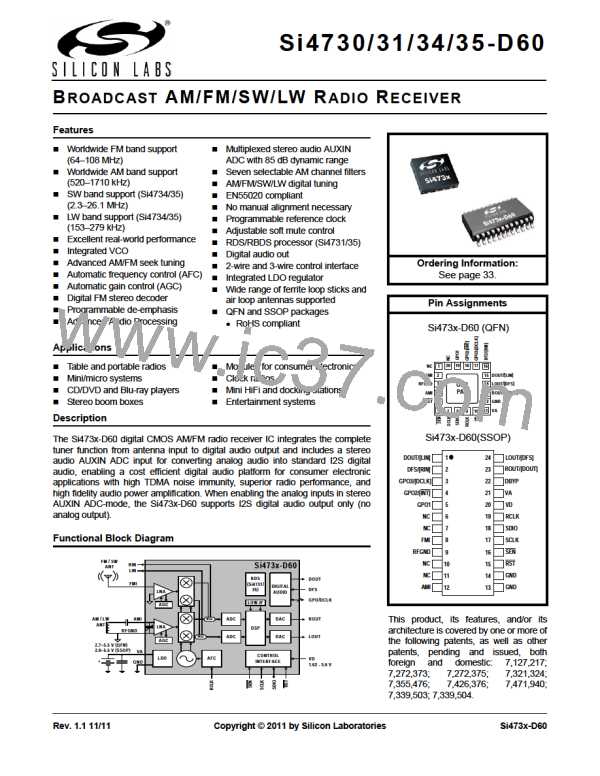Si4730/31/34/35-D60
The Si473x-D60 uses RSSI, SNR, and AFC to qualify
stations. Most of these variables have programmable
thresholds for modifying the seek function according to
customer needs.
4.15. De-emphasis
Pre-emphasis and de-emphasis is a technique used by
FM broadcasters to improve the signal-to-noise ratio of
FM receivers by reducing the effects of high-frequency
interference and noise. When the FM signal is
RSSI is employed first to screen all possible candidate
stations. SNR and AFC are subsequently used in
screening the RSSI qualified stations. The more
thresholds the system engages, the higher the
confidence that any found stations will indeed be valid
broadcast stations. The Si473x-D60 defaults set RSSI
to a mid-level threshold and add an SNR threshold set
to a level delivering acceptable audio performance. This
trade-off will eliminate very low RSSI stations while
keeping the seek time to acceptable levels. Generally,
the time to auto-scan and store valid channels for an
entire FM band with all thresholds engaged is very short
depending on the band content. Seek is initiated using
the FM_SEEK_START command. The RSSI, SNR, and
AFC threshold settings are adjustable using properties.
transmitted,
a
pre-emphasis filter is applied to
accentuate the high audio frequencies. The Si473x-D60
incorporates a de-emphasis filter which attenuates high
frequencies to restore a flat frequency response. Two
time constants are used in various regions. The de-
emphasis time constant is programmable to 50 or 75 µs
and is set by the FM_DEEMPHASIS property.
4.16. RDS/RBDS Processor
(Si4731/35 Only)
The Si4731/35 implements an RDS/RBDS* processor
for symbol decoding, block synchronization, error
detection, and error correction.
The Si4731/35 device is user configurable and provides
an optional interrupt when RDS is synchronized, loses
synchronization, and/or the user configurable RDS
FIFO threshold has been met.
4.19. Reference Clock
The Si473x-D60 reference clock is programmable,
supporting RCLK frequencies listed in Table 12,
“Reference Clock and Crystal Characteristics,” on
page 18. Refer to Table 2, “DC Characteristics,” on
page 6 for switching voltage levels and Table 12 for
frequency tolerance information.
The Si4731/35 reports RDS decoder synchronization
status and detailed bit errors in the information word for
each RDS block with the FM_RDS_STATUS command.
The range of reportable block errors is 0, 1–2, 3–5, or
6+. More than six errors indicates that the
corresponding block information word contains six or
more non-correctable errors or that the block checkword
contains errors. The pilot does not have to be present to
decode RDS/RBDS.
An onboard crystal oscillator is available to generate the
32.768 kHz reference when an external crystal and load
capacitors are provided. Refer to "2. Typical Application
Schematic" on page 20. This mode is enabled using the
POWER_UP command. Refer to “AN332: Si47xx
Programming Guide”.
*Note: RDS/RBDS is referred to only as RDS throughout the
remainder of this document.
The Si473x-D60 performance may be affected by data
activity on the SDIO bus when using the integrated
internal oscillator. SDIO activity results from polling the
tuner for status or communicating with other devices
that share the SDIO bus. If there is SDIO bus activity
while the Si473x-D60 is performing the seek/tune
function, the crystal oscillator may experience jitter,
which may result in mistunes, false stops, and/or lower
SNR.
4.17. Tuning
The tuning frequency is directly programmed using the
FM_TUNE_FREQ and AM_TUNE_FREQ commands.
The Si473x-D60 supports channel spacing steps of
10 kHz in FM mode and 1 kHz in AM mode.
4.18. Seek
The Si473x-D60 seek functionality is performed
completely on-chip and will search up or down the
selected frequency band for a valid channel. A valid
For best seek/tune results, Silicon Laboratories
recommends that all SDIO data traffic be suspended
during Si473x-D60 seek and tune operations. This is
achieved by keeping the bus quiet for all other devices
on the bus, and delaying tuner polling until the tune or
seek operation is complete. The seek/tune complete
(STC) interrupt should be used instead of polling to
determine when a seek/tune operation is complete.
channel is qualified according to
a
series of
programmable signal indicators and thresholds. The
seek function can be made to stop at the band edge and
provide an interrupt, or wrap the band and continue
seeking until arriving at the original departure frequency.
The device sets interrupts with found valid stations or, if
the seek results in zero found valid stations, the device
indicates failure and again sets an interrupt. Refer to
“AN332: Si47xx Programming Guide”.
28
Rev. 1.1
